18.6 Disorders of Cognition
Most of us worry from time to time that we are losing our memory and other mental abilities (Glauberman, 2014). You rush out the door without your keys, you meet a familiar person and cannot remember her name, or you forget that you have seen a particular film. Actually such mishaps are a common and quite normal feature of stress or of aging. As people move through middle age, these memory difficulties and lapses of attention increase, and they may occur regularly by the age of 60 or 70 (see MindTech below). Sometimes, however, people have memory and other cognitive changes that are far more extensive and problematic.
In Chapter 6 you saw that problems in memory and related cognitive processes can occur without biological causes, in the form of dissociative disorders. More often, though, cognitive problems do have organic roots, particularly when they appear late in life. The leading such disorders among the elderly are delirium, major neurocognitive disorder, and mild neurocognitive disorder.
MindTech
Remember to Tweet; Tweet to Remember


Social media sites such as Facebook and Twitter, and the Internet in general, are often thought of as the province of the young. However, elderly people are going online and joining social networking sites at increasing rates (Pew Internet, 2014). Some 45 percent of all elderly people online now use Facebook (up from 35 percent a year ago); 9 percent use Pinterest; 5 percent tweet, and 1 percent use Instagram—
Of course it’s interesting—
What other factors might help explain the link between social networking and better coping, social functioning, and emotions among the elderly?
One study in Italy, for example, focused on residents from two elder-
Similarly, in a 2013 study, researchers at the University of Arizona recruited 42 adults, aged 68 to 91, and trained 14 of them on Facebook (Piatt, 2013; Wohltmann, 2013). The study found a 25 percent improvement in the cognitive performances of the 14 participants, including improvements in their mental “updating” skills—
Many elderly people resist the Internet and social networking, saying things like “It’s not for me,” “It intimidates me,” or “You can’t teach an old dog new tricks.” However, this growing body of research suggests that they may want to embrace social networking and the Internet for better functioning and for better mental health. ![]()
Delirium
Delirium is a major disturbance in attention and orientation to the environment (see Table 18-1). As the person’s focus becomes less clear, he or she has great difficulty concentrating and thinking in an organized way, leading to misinterpretations, illusions, and on occasion, hallucinations (Lawlor & Bush, 2014; Eeles & Bhat, 2010). Sufferers may believe that it is morning in the middle of the night or that they are home when actually they are in a hospital room.
 delirium A rapidly developing, acute disturbance in attention and orientation that makes it very difficult to concentrate and think in a clear and organized manner
delirium A rapidly developing, acute disturbance in attention and orientation that makes it very difficult to concentrate and think in a clear and organized manner
|
Delirium |
|
|---|---|
|
1. |
Over the course of hours or a few days, individual experiences fast- |
|
2. |
Individual also displays a significant cognitive disturbance. |
|
(Information from: APA, 2013) |
|
This state of massive confusion typically develops over a short period of time, usually hours or days (APA, 2013). Delirium may occur in any age group, including children, but is most common in elderly people. Fewer than 0.5 percent of the nonelderly population experience delirium, compared with 1 percent of people over 55 years of age and 14 percent of those over 85 years of age (Tune & DeWitt, 2011). When elderly people enter a hospital to be treated for a general medical condition, 1 in 10 of them shows the symptoms of delirium. At least another 10 percent develop delirium during their stay in the hospital (Bagnall & Faiz, 2014; Inouye, 2006; Inouye et al., 2003). Around 17 percent of patients admitted for surgery develop delirium (de Castro et al., 2014). That number rises to 23 percent among those admitted suddenly for acute surgery. Sixty percent of nursing home residents older than 75 years of age have some delirium, compared with 35 percent of similar people living independently with the assistance of home health services (Tune & DeWitt, 2011).
Fever, certain diseases and infections, poor nutrition, head injuries, strokes, and stress (including the trauma of surgery) may all cause delirium (Lawlor & Bush, 2014; Eeles & Bhat, 2010; Wetterling, 2005). So may intoxication by certain substances, such as prescription drugs. Partly because older people face so many of these problems, they are more likely than younger ones to experience delirium. If a clinician accurately identifies delirium, it can often be easy to correct—
Alzheimer’s Disease and Other Neurocognitive Disorders
People with a neurocognitive disorder experience a significant decline in at least one (often more than one) area of cognitive functioning, such as memory and learning, attention, visual perception, planning and decision making, language ability, or social awareness (APA, 2013). Those who have certain types of neurocognitive disorders may also undergo personality changes—
 neurocognitive disorder A disorder marked by a significant decline in at least one area of cognitive functioning.
neurocognitive disorder A disorder marked by a significant decline in at least one area of cognitive functioning.
If the person’s cognitive decline is substantial and interferes significantly with his or her ability to be independent, a diagnosis of major neurocognitive disorder is in order. If the decline is modest and does not interfere with independent functioning, the appropriate diagnosis is mild neurocognitive disorder (see Table 18-2).
 major neurocognitive disorder A neurocognitive disorder in which the decline in cognitive functioning is substantial and interferes with a person’s ability to be independent.
major neurocognitive disorder A neurocognitive disorder in which the decline in cognitive functioning is substantial and interferes with a person’s ability to be independent.
 mild neurocognitive disorder A neurocognitive disorder in which the decline in cognitive functioning is modest and does not interfere with a person’s ability to be independent.
mild neurocognitive disorder A neurocognitive disorder in which the decline in cognitive functioning is modest and does not interfere with a person’s ability to be independent.
|
Major Neurocognitive Disorder |
|
|---|---|
|
1. |
Individual displays substantial decline in at least one of the following areas of cognitive function: • Memory and learning • Attention • Perceptual- |
|
2. |
Cognitive deficits interfere with the individual’s everyday independence. |
|
Mild Neurocognitive Disorder |
|
|
1. |
Individual displays modest decline in at least one of the following areas of cognitive function: • Memory and learning • Attention • Perceptual- |
|
2. |
Cognitive deficits do not interfere with the individual’s everyday independence. |
|
(Information from: APA, 2013). |
|
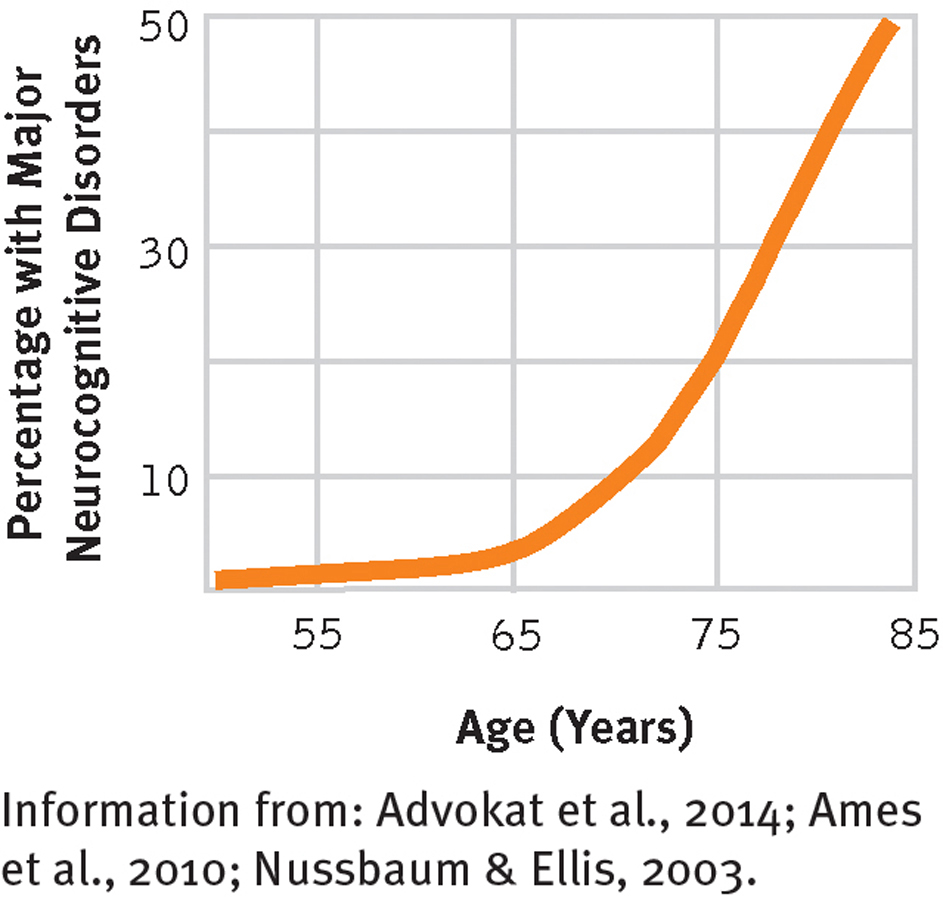
Substantial cognitive decline and age
The occurrence of substantial cognitive decline is closely related to age. Fewer than 1 percent of all 60-
There are currently 44 million people with neurocognitive disorders around the world, with 4.6 million new cases emerging each year (Hollingworth et al., 2011). The number of cases is expected to reach 135 million by 2050 unless a cure is found (Sifferlin, 2013). The occurrence of neurocognitive disorders is closely related to age (see Figure 18-2). Among people 65 years of age, the prevalence is around 1 to 2 percent, increasing to as much as 50 percent among those over the age of 85 (Zhao et al., 2014; Apostolova & Cummings, 2008).
As you read earlier, Alzheimer’s disease is the most common type of neurocognitive disorder, accounting for around two-
 Alzheimer’s disease The most common type of neurocognitive disorder, usually occurring after the age of 65, marked most prominently by memory impairment.
Alzheimer’s disease The most common type of neurocognitive disorder, usually occurring after the age of 65, marked most prominently by memory impairment.
Alzheimer’s disease is a gradually progressive disease in which memory impairment is the most prominent cognitive dysfunction (APA, 2013). Technically, sufferers receive a DSM-
|
Neurocognitive Disorder Due to Alzheimer’s Disease |
|
|---|---|
|
1. |
Individual displays the features of major or mild neurocognitive disorder. |
|
2. |
Memory impairment is a prominent feature. |
|
3. |
Genetic indications or family history of Alzheimer disease underscore diagnosis, but are not essential to diagnosis. |
|
4. |
Symptoms are not due to other types of disorders or medical problems. |
|
(Information from: APA, 2013) |
|
Alzheimer’s disease is named after Alois Alzheimer, the German physician who formally identified it in 1907. Alzheimer first became aware of the syndrome in 1901 when a new patient, Auguste D., was placed under his care:
On November 25, 1901, a … woman with no personal or family history of mental illness was admitted to a psychiatric hospital in Frankfurt, Germany, by her husband, who could no longer ignore or hide quirks and lapses that had overtaken her in recent months. First, there were unexplainable bursts of anger, and then a strange series of memory problems. She became increasingly unable to locate things in her own home and began to make surprising mistakes in the kitchen. By the time she arrived at Städtische Irrenanstalt, the Frankfurt Hospital for the Mentally Ill and Epileptics, her condition was as severe as it was curious. The attending doctor, senior physician Alois Alzheimer, began the new file with these notes….
She sits on the bed with a helpless expression.
“What is your name?”
Auguste.
“Last name?”
Auguste.
“What is your husband’s name?”
Auguste, I think.
“How long have you been here?” (She seems to be trying to remember.)
Three weeks.
It was her second day in the hospital. Dr. Alzheimer, a thirty-
He spoke her name again. She wrote “Augu” and again stopped.
When Alzheimer prompted her a third time, she was able to write her entire first name and the initial “D” before finally giving up, telling the doctor, “I have lost myself.”
Her condition did not improve. It became apparent that there was nothing that anyone at this or any other hospital could do for Frau D. except to insure her safety and try to keep her as clean and comfortable as possible for the rest of her days. Over the next four and a half years, she became increasingly disoriented, delusional, and incoherent. She was often hostile.
“Her gestures showed a complete helplessness,” Alzheimer later noted in a published report. “She was disoriented as to time and place. From time to time she would state that she did not understand anything, that she felt confused and totally lost…. Often she would scream for hours and hours in a horrible voice.”
By November 1904, three and a half years into her illness, Auguste D. was bedridden, incontinent, and largely immobile…. Notes from October 1905 indicate that she had become permanently curled up in a fetal position with her knees drawn up to her chest, muttering but unable to speak, and requiring assistance to be fed.
(Shenk, 2001, pp. 12-
Although some people with Alzheimer’s disease may survive for as many as 20 years, the time between onset and death is typically 8 to 10 years (Advokat et al., 2014; Soukup, 2006). It usually begins with mild memory problems, lapses of attention, and difficulties in language and communication (Farlow, 2010). As symptoms worsen, the person has trouble completing complicated tasks or remembering important appointments. Eventually sufferers also have difficulty with simple tasks, forget distant memories, and have changes in personality that often become very noticeable. For example, a gentle man may become uncharacteristically aggressive.
People with Alzheimer’s disease may at first deny that they have a problem, but they soon become anxious or depressed about their state of mind; many also become agitated. A woman from Virginia describes her memory loss as the disease progresses:
Very often I wander around looking for something which I know is very pertinent, but then after a while I forget about what it is I was looking for…. Once the idea is lost, everything is lost and I have nothing to do but wander around trying to figure out what it was that was so important earlier.
(Shenk, 2001, p. 43)
As the neurocognitive symptoms intensify, people with Alzheimer’s disease show less and less awareness of their limitations. They may withdraw from others during the late stages of the disorder, become more confused about time and place, wander, and show very poor judgment. Eventually they become fully dependent on other people. They may lose almost all knowledge of the past and fail to recognize the faces of even close relatives. They also become increasingly uncomfortable at night and take frequent naps during the day (Ames et al., 2010; Edelstein et al., 2008). During the late phases of the disorder, they require constant care.
People with Alzheimer’s usually remain in fairly good health until the later stages of the disease. As their mental functioning declines, however, they become less active and spend much of their time just sitting or lying in bed. This makes them prone to develop illnesses such as pneumonia, which can result in death (Park et al., 2014; Ames et al., 2010). Alzheimer’s disease is currently responsible for close to 84,000 deaths each year in the United States, a number that is 40 percent higher than it was a decade ago (NCHS, 2014). It is the sixth leading cause of death in the country, the third leading cause among the elderly (CDC, 2013, 2010).
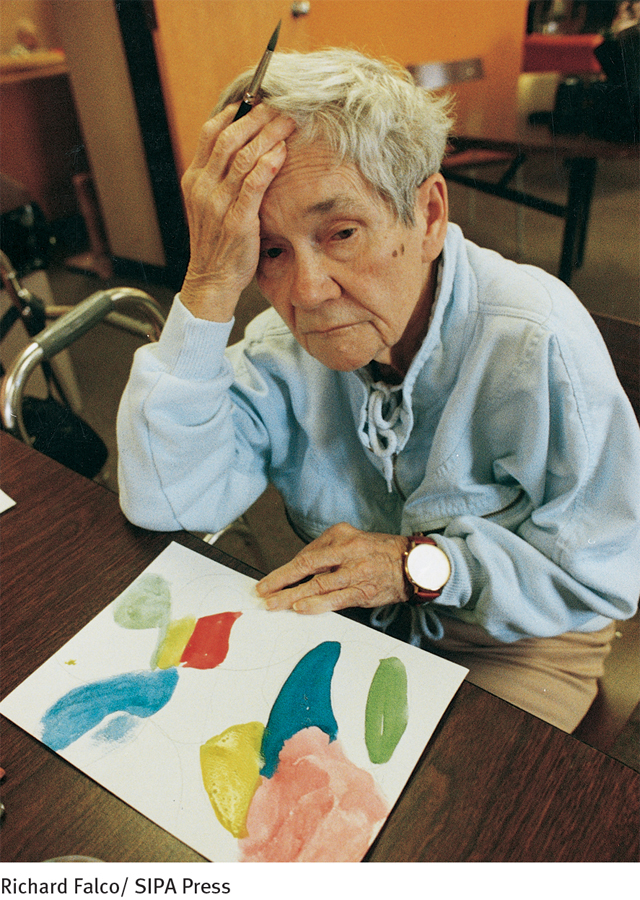
In most cases, Alzheimer’s disease can be diagnosed with certainty only after death, when structural changes in the person’s brain, such as excessive senile plaques and neurofibrillary tangles, can be fully examined. Senile plaques are sphere-
 senile plaques Sphere-
senile plaques Sphere-
 neurofibrillary tangles Twisted protein fibers that form within certain brain cells as people age. People with Alzheimer’s disease have an excessive number of such tangles.
neurofibrillary tangles Twisted protein fibers that form within certain brain cells as people age. People with Alzheimer’s disease have an excessive number of such tangles.
Scientists do not fully understand what role excessive numbers of plaques and tangles play in Alzheimer’s disease, but they suspect they are very important. Today’s leading explanations for this disease center on these plaques and tangles and on the various factors that may contribute to their formation.
What Are the Genetic Causes of Alzheimer’s Disease?To understand the genetic theories of Alzheimer’s disease, we must first appreciate the nature and role of proteins. Proteins are fundamental components of all living cells, including, of course, brain cells. They are large molecules made up of chains of carbon, hydrogen, oxygen, nitrogen, and sulfur. There are many different kinds of proteins, each with a different function. Collectively, they are essential for the proper functioning of an organism.
The plaques and tangles that are so plentiful in the brains of Alzheimer’s patients seem to occur when two important proteins start acting in a frenzied manner. Abnormal activity by the beta-
What causes this chain of events? Genetic factors are a major culprit. However, the genetic factors that are responsible differ for the early-
EARLY-
LATE-
A gene called the apolipoprotein E (ApoE) gene, located on chromosome 19, is normally responsible for the production of a protein that helps carry various fats into the bloodstream. This gene comes in various forms. About 30 percent of the population inherit the form called ApoE-
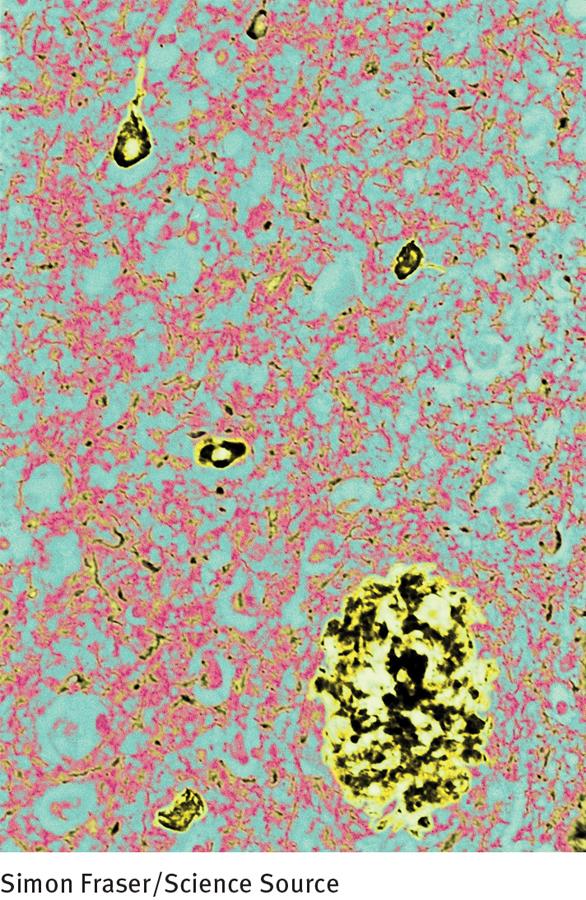
Although the ApoE-
AN ALTERNATIVE GENETIC THEORY OF ALZHEIMER’S DISEASEAs you have just read, the leading genetic theories of Alzheimer’s disease point to gene forms, such as ApoE-
How Does Brain Structure Relate to Alzheimer’s Disease?We know that genetic factors may predispose people to Alzheimer’s disease, but we still need to know what abnormalities in brain structure eventually result from such factors—
The human brain has two memory systems that work together to help us learn and recall. Short-term memory, or working memory, gathers new information. Long-term memory is the accumulation of information that we have stored over the years, information that first made its way through the short-
 short-term memory The memory system that collects new information. Also known as working memory.
short-term memory The memory system that collects new information. Also known as working memory.
 long-term memory The memory system that contains all the information that we have stored over the years.
long-term memory The memory system that contains all the information that we have stored over the years.
Certain brain structures seem to be especially important in memory. Among the most important structures in short-
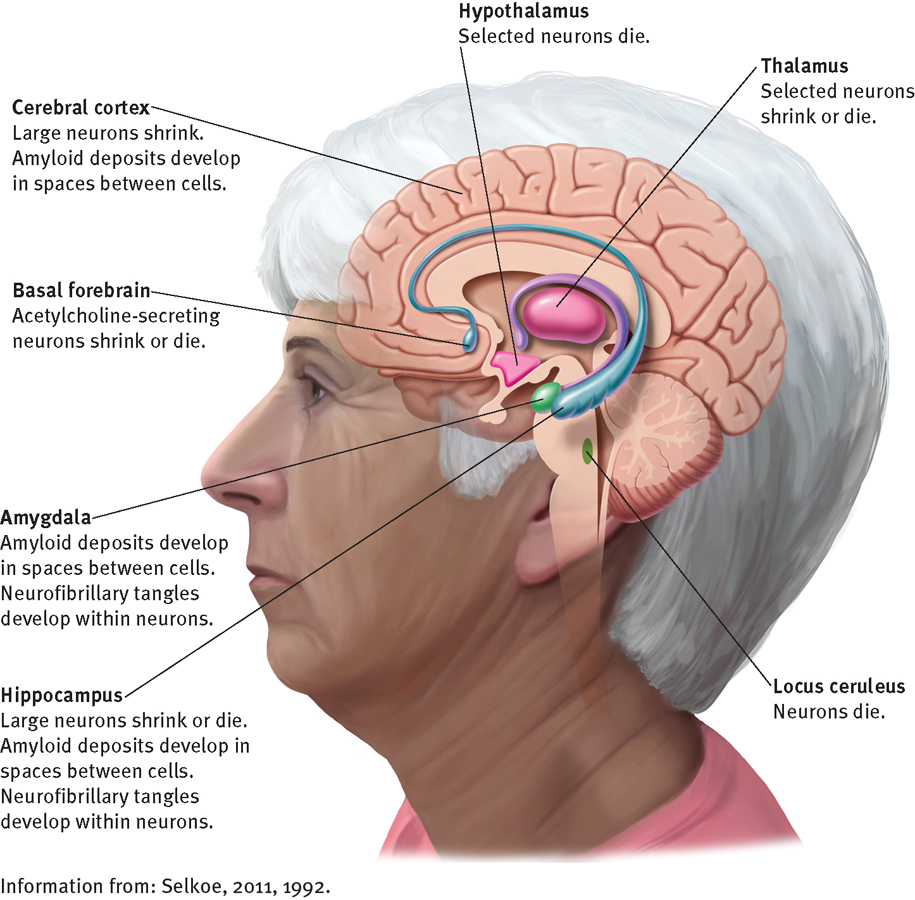
The aging brain
In old age, the brain undergoes changes that affect cognitive functions such as memory, learning, and reasoning to some degree. The same changes occur to an excessive degree in people with Alzheimer’s disease.

What Biochemical Changes in the Brain Relate to Alzheimer’s Disease?Memory researchers have also identified biochemical changes that occur in cells as memories form. In order for new information to be acquired and stored, certain proteins must be produced in key brain cells. Several chemicals—
Some research suggests that abnormal activity by these various chemicals may contribute to the symptoms of Alzheimer’s disease. Studies have found, for example, that acetylcholine and glutamate are in low supply, or at least function differently, in the brains of Alzheimer’s victims, and other studies suggest that Alzheimer’s victims have an imbalance in the breakdown of calcium (Canas et al., 2014).
Other Explanations of Alzheimer’s DiseaseSeveral lines of research suggest that certain substances found in nature may act as toxins, damage the brain, and contribute to the development of Alzheimer’s disease. For example, researchers have detected high levels of zinc in the brains of some Alzheimer’s patients (Xu et al., 2014; Schrag et al., 2011). This finding has gained particular attention because in some animal studies zinc has been observed to trigger a clumping of the beta-
Another line of research suggests that the environmental toxin lead may contribute to the development of Alzheimer’s disease (Lee & Freeman, 2014; Ritter, 2008). Lead was phased out of gasoline products between 1976 and 1991, leading to an 80 percent drop of lead levels in people’s blood. However, many of today’s elderly were exposed to high levels of lead in the 1960s and 1970s, regularly inhaling air pollution from vehicle exhausts—
One study, for example, examined elderly people and scanned their shinbones for lead (Schwartz & Stewart, 2007). Interpreting shinbone levels of lead as indicators of the person’s lifetime exposures to lead, the researchers found that the higher a person’s lifetime lead exposure, the more poorly he or she performed on memory and language tests. An important question here is: Why would cognitive dysfunction first appear decades after exposure to the toxin? Medical researcher Philip Landrigan (2007) suggests, “If a substance destroys brain cells in early life, the brain may cope by drawing on its reserve capacity until [eventually] it loses more cells with aging…. Only then would symptoms like forgetfulness or tremors begin.”
Two other explanations for Alzheimer’s disease have also been offered. One is the autoimmune theory. On the basis of certain irregularities found in the immune systems of people with Alzheimer’s disease, several researchers have speculated that changes in aging brain cells may trigger an autoimmune response (that is, a mistaken attack by the immune system against itself) that helps lead to the disease (Marchese et al., 2014; Zipp & Aktas, 2006). The other explanation is a viral theory. Because Alzheimer’s disease resembles Creutzfeldt-
Assessing and Predicting Alzheimer’s DiseaseAs you read earlier, most cases of Alzheimer’s disease can be diagnosed with absolute certainty only after death, when an autopsy is performed. However, brain scans, which reveal abnormalities in the living brain, now are used commonly as assessment tools and often provide clinicians with considerable confidence in their diagnoses of Alzheimer’s disease (Rabin, 2013; Yamasaki et al., 2012; Berti et al., 2011). In addition, several research teams currently are trying to develop tools that can identify those people who are likely to develop Alzheimer’s disease and other types of neurocognitive disorders.
One promising line of work, for example, comes from the laboratory of neuroscientist Lisa Mosconi and her colleagues (Mosconi, 2013; Mosconi et al., 2010, 2008; de Leon et al., 2007). Using a special kind of PET scan, this research team examined activity in certain parts of the hippocampus in dozens of elderly research participants and then conducted follow-

DSM-5 CONTROVERSY
Normal Decline?
DSM-
As you will see shortly, the most effective interventions for Alzheimer’s disease and other types of neurocognitive disorders are those that help prevent these problems, or at least ones that are applied early. Clearly, then, it is essential to have tools that identify the disorders as early as possible, preferably years before the onset of symptoms (Rabin, 2013). That is what makes the research advances in assessment and diagnosis so exciting.
Would people be better off knowing that they will eventually develop a disease that has no known cure?
Other Types of Neurocognitive DisordersThere are a number of neurocognitive disorders in addition to Alzheimer’s disease (APA, 2013) (see PsychWatch on pages 626–
Frontotemporal neurocognitive disorder, also known as Pick’s disease, is a rare disorder that affects the frontal and temporal lobes. It has a clinical picture similar to Alzheimer’s disease, but the two diseases can be distinguished at autopsy.
Neurocognitive disorder due to prion disease, also called Creutzfeldt-
Neurocognitive disorder due to Huntington’s disease is an inherited progressive disease in which memory problems, along with personality changes and mood difficulties, worsen over time. People with Huntington’s have movement problems, too, such as severe twitching and spasms. Children of people with Huntington’s disease have a 50 percent chance of developing it.
Parkinson’s disease, the slowly progressive neurological disorder marked by tremors, rigidity, and unsteadiness, can result in neurocognitive disorder due to Parkinson’s disease, particularly in older people or those whose cases are advanced.
Yet other neurocognitive disorders may be caused by HIV infections, traumatic brain injury, substance abuse, or various medical conditions such as meningitis or advanced syphilis.

What Treatments Are Currently Available for Alzheimer’s Disease and Other Neurocognitive Disorders?Treatments for the cognitive features of Alzheimer’s disease and most other types of neurocognitive disorders have been at best modestly helpful. A number of approaches have been applied, including drug therapy, cognitive techniques, behavioral interventions, support for caregivers, and sociocultural approaches.
BETWEEN THE LINES
Busy Mind, Healthier Brain
Researchers have found fewer plaques and tangles in the brains of lab mice that live in intellectually and physically stimulating environments—
DRUG TREATMENTThe drugs currently prescribed for Alzheimer’s patients are designed to affect acetylcholine and glutamate, the neurotransmitters that play important roles in memory. Such drugs include tacrine (trade name Cognex), donepezil (Aricept), rivastigmine (Exelon), galantamine (Reminyl), and memantine (Namenda). The short-
The drugs just discussed are each prescribed after a person has developed Alzheimer’s disease. In contrast, studies suggest that certain substances now available on the marketplace for other kinds of problems may help prevent or delay the onset of Alzheimer’s disease. For example, some studies have found that women who took estrogen, the female sex hormone, for years after menopause cut their risk of developing Alzheimer’s disease in half (Li, Cui, & Shen, 2014; Kawas et al., 1997). Other studies have suggested that the long-
COGNITIVE TECHNIQUESCognitive treatments have been used in cases of Alzheimer’s disease, with some temporary success. In Japan, for example, a number of people with the disease meet regularly in classes, performing simple calculations and reading essays and novels aloud. Proponents of this approach claim that it serves as a mental exercise that helps rehabilitate those parts of the brain linked to memory, reasoning, and judgment. Similarly, some research suggests that cognitive activities, including computer-
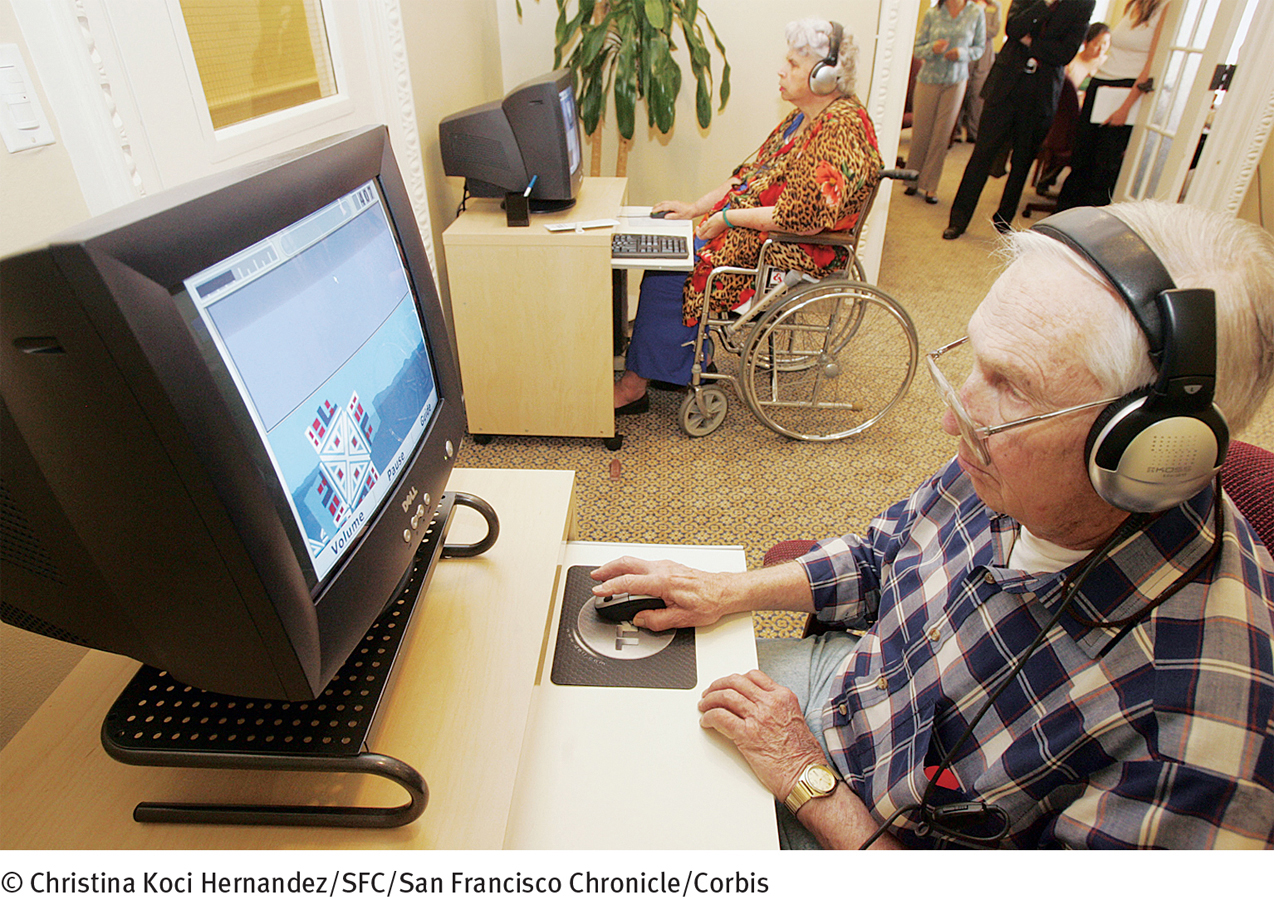
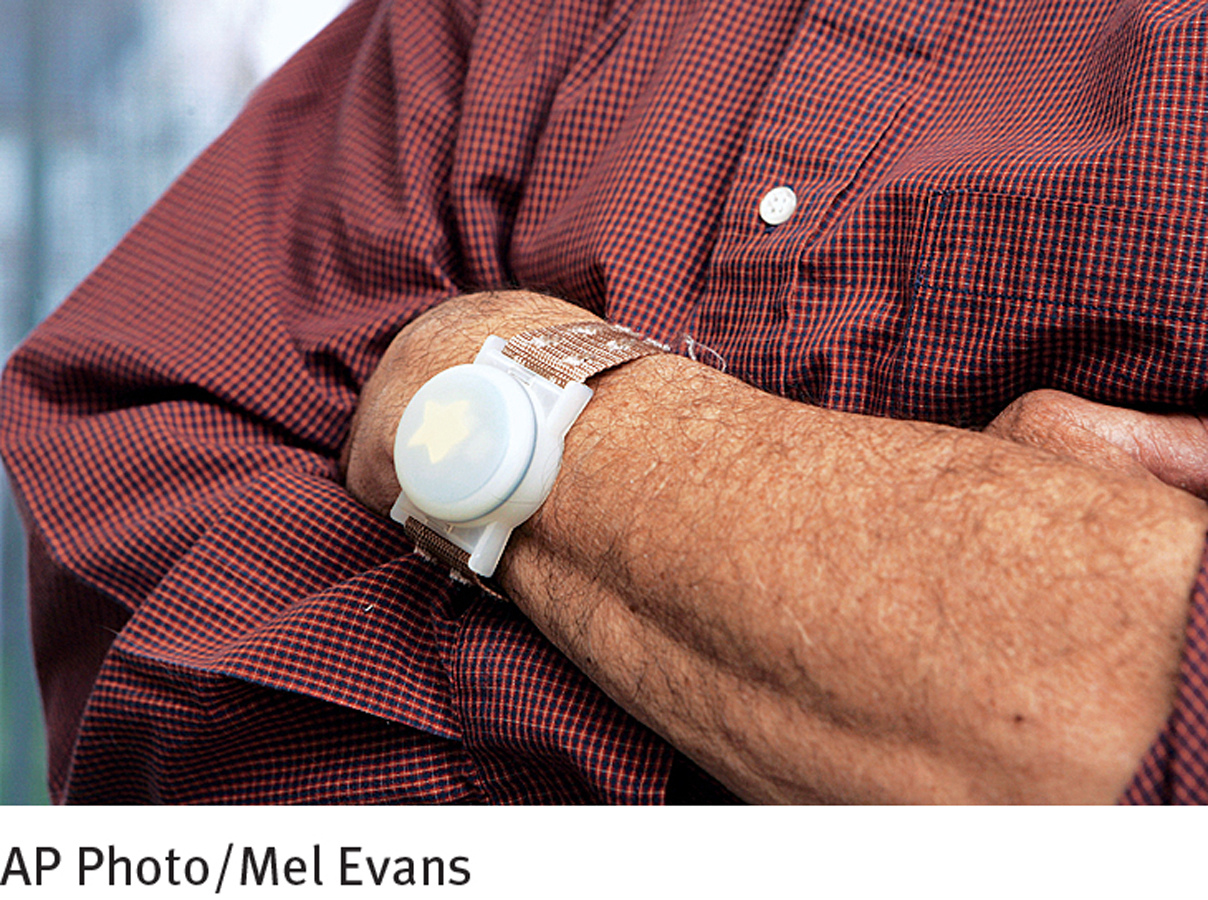
BEHAVIORAL INTERVENTIONSBehavioral interventions have also been somewhat successful in helping Alzheimer’s patients. It has become increasingly clear across many studies that physical exercise helps improve cognitive functioning—
PsychWatch
Damaging the Brain
A leading cause of neurocognitive disorders is damage to the brain—
Retrograde amnesia is an inability to remember events from the past. Anterograde amnesia is an ongoing inability to form new memories. In anterograde amnesia, it is as though information from short-
Korsakoff’s Syndrome
Fred, a 69-
Fred … had a history of many years of heavy drinking, although he denied drinking during the past several years. When seen in the admitting ward, the patient was neatly dressed, but there was some deterioration of his personal habits. Although pleasant and sociable with the interviewer and ward personnel, he was definitely confused. He wandered about the ward, investigating objects and trying on other people’s clothing. He talked freely, though his speech tended to be rambling and at times incoherent. Most of his spontaneous conversation centered on himself, and there were a number of hypochondriacal complaints. Fred was disoriented for time and place, although he was able to give his name. He could not give his correct address, said his age was 91, and was unable to name the day, the month, or the year. He did not know where he was, although he said he was sent here by his landlord because he had been drinking…. [Fred] showed the characteristic symptom picture of Korsakoff’s syndrome, with disorientation, confusion, and a strong tendency toward confabulation. When asked where he was, he said he was in a brewery. He gave the name of the brewery, but when asked the same question a few minutes later, he named another brewery. Similarly, he said that he knew the examiner, called him by an incorrect name, and a little later changed the name again. When leaving the examining room, he used still another name when he said politely, “Goodbye, Mr. Wolf!”
(KISKER, 1977, p. 308)

As you’ll recall from Chapter 12, approximately 5 percent of people with chronic alcoholism develop Korsakoff’s syndrome. A combination of excessive drinking and improper diet produce a deficiency of vitamin B (thiamine), which leads to damage in key memory regions of the brain (Nilsson & Sonne, 2013; Hirstein, 2011). People with Korsakoff’s syndrome primarily lose memories of factual knowledge but maintain their intellectual and language skills. Thus, like Fred, many confabulate—repeatedly: they use their general intellect to make up elaborate stories and lies in an effort to replace the memories they keep losing.
Head Injuries and Brain Surgery
Both head injuries and brain surgery can cause significant memory problems (Sinha, Nehra, & Sharma, 2014; Zeckey et al., 2011). Either may destroy memory-
Each year, around 1.7 million people in the United States sustain a head injury (CDC, 2014). Television shows and movies often portray bumps on the head as a quick and easy way to lose one’s memory. In fact, single episodes of mild head injuries, such as a concussion that does not result in coma or a period of unconsciousness, seem unlikely to cause much memory loss. In contrast, almost half of all severe head injuries or repeated mild head injuries can cause some permanent learning and memory problems, both anterograde and retrograde (Ng et al., 2014). In everyday life, the leading causes of severe brain injuries are car accidents and falls (CDC, 2014).
Given these dangers, the public has become very concerned by the recent release of information that tens of thousands of U.S. soldiers who fought in Afghanistan and Iraq have suffered head injuries from exposure to blasts during combat. Estimates are that at least 20,000, and perhaps as many as 320,000, combat veterans have sustained such injuries (Welberg, 2012; RAND, 2008; Marchione, 2007). While it may be that most such brain injuries are mild, clinical practitioners and researchers caution that they do not yet know how severe or long lasting these injuries will turn out to be.
Brain surgery may create more specific memory problems. The most famous case of memory loss as a result of brain surgery was that of a man called H.M. by researchers (Milner, 2010). In 1953, surgeons decided to treat H.M.’s brain seizure disorder, or epilepsy, by removing parts of both of his temporal lobes, along with the amygdala and hippocampus. At that time, the involvement of these brain areas in the formation of memories was not known. (Today temporal lobe surgery is usually limited to either the right or left side of the brain.) From that day forward, H.M. experienced severe anterograde amnesia. For the remaining half-
Behavioral interventions of a different kind have been used to help improve specific symptoms displayed by Alzheimer’s patients. The approaches typically focus on changing everyday patient behaviors that are stressful for the family, such as wandering at night, loss of bladder control, demands for attention, and inadequate personal care (Lancioni et al., 2011; Lindsey, 2011; Knight et al., 2006). The behavioral therapists use a combination of role-
SUPPORT FOR CAREGIVERSCaregiving can take a heavy toll on the close relatives of people with Alzheimer’s disease and other types of neurocognitive disorders (Kang et al., 2014; Llanque et al., 2014). Almost 90 percent of all people with Alzheimer’s disease are cared for by their relatives (Alzheimer’s Association, 2014, 2007). It is hard to take care of someone who is becoming increasingly lost, helpless, and medically ill. And it is very painful to witness mental and physical decline in someone you love.
I have really struggled with the honesty issue. What do you say to someone who sits on her bed and says that she has never stayed out overnight without letting her parents know where she is? What do you say to someone who thinks she is a teacher and if she doesn’t get home and into her classroom there will be a whole class of children left unattended? What do you say to someone who thinks she has no money to pay bills and will lose everything she owns if she doesn’t get home to a job that you know she has been retired from for years? I couldn’t find any reason for telling her over and over that she has a horrible terrible degenerating disease that was making her feel the way she does.
I found that she became less anxious if I just listened to what she was saying and feeling. Sometimes saying nothing was better than anything I could say. Telling her that I would take care of some of these things put her a bit more at ease. It may feel better for me to verbalize the facts, but what she needs is comfort and security—
(Shenk, 2001, p. 147)
One of the most frequent reasons for the institutionalization of people with Alzheimer’s disease is that overwhelmed caregivers can no longer cope with the difficulties of keeping them at home (Di Rosa et al., 2011;Apostolova & Cummings, 2008). Many caregivers experience anger and depression, and their own physical and mental health often declines (Kang et al., 2014; Pinquart & Sörensen, 2011; Kantrowitz &Springen, 2007). Clinicians now recognize that one of the most important aspects of treating Alzheimer’s disease and other types of neurocognitive disorders is to focus on the emotional needs of the caregivers, including their needs for regular time out, education about the disease, and psychotherapy (Mittelman & Bartels, 2014; McKenzie & Teri, 2011). Some clinicians also provide care-
SOCIOCULTURAL APPROACHESSociocultural approaches play an important role in treatment (Pongan et al., 2012; Brooks, 2005; Kalb, 2000) (see MediaSpeak below). A number of day-
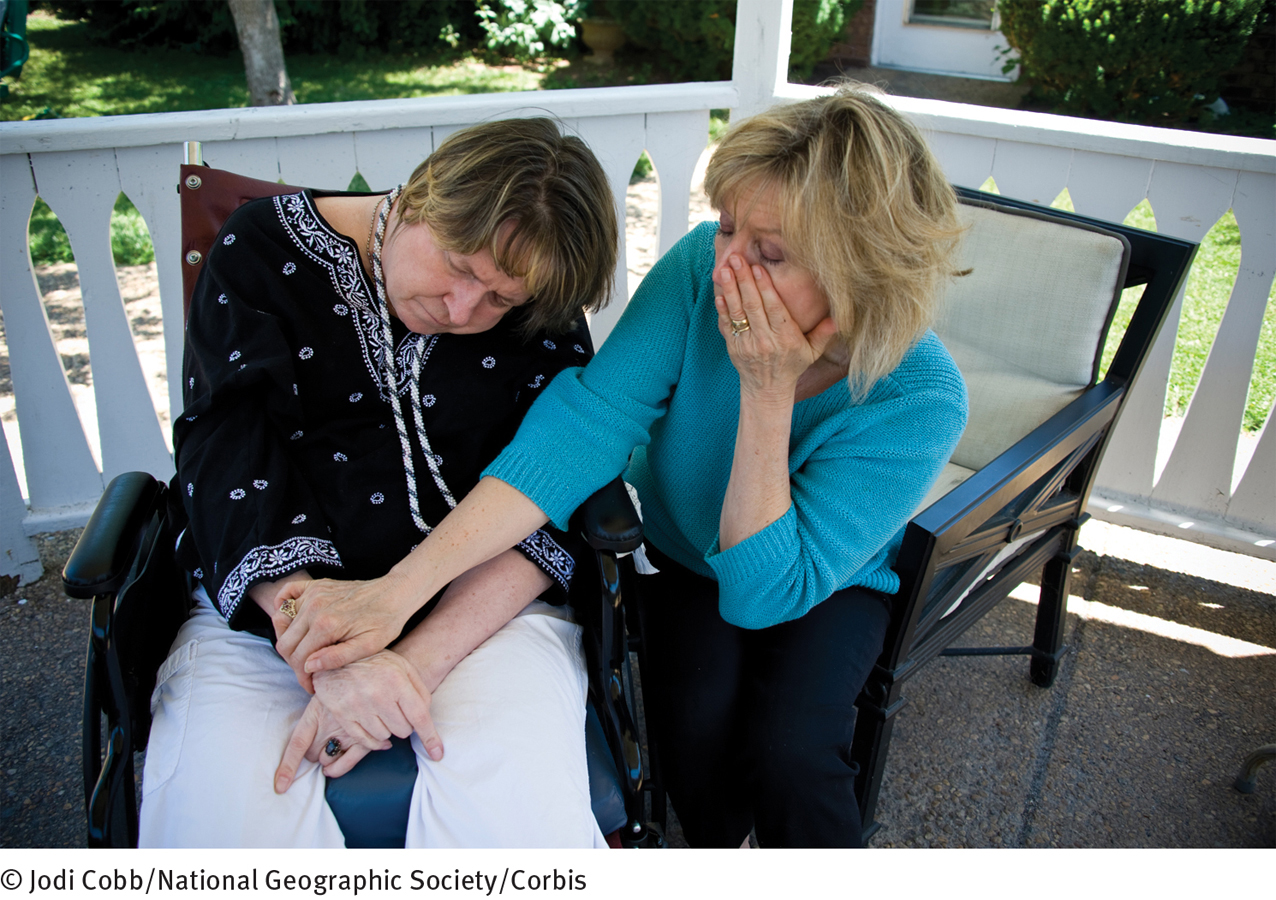
MediaSpeak
Focusing on Emotions
By Pam Belluck, The New York Times, January 1, 2011
Margaret Nance was, to put it mildly, a difficult case. Agitated, combative, often reluctant to eat, she would hit staff members and fellow residents at nursing homes, several of which kicked her out. But when Beatitudes nursing home agreed to an urgent plea to accept her, all that changed.
Disregarding typical nursing-
And she was given a baby doll, a move that seemed so jarring that a supervisor initially objected until she saw how calm Ms. Nance became when she rocked, caressed and fed her “baby,” often agreeing to eat herself after the doll “ate” several spoonfuls.
Dementia patients at Beatitudes are allowed practically anything that brings comfort, even an alcoholic “nip at night,” said Tena Alonzo, director of research. “Whatever your vice is, we’re your folks,” she said….
It is an unusual posture for a nursing home, but Beatitudes is actually following some of the latest science. Research suggests that creating positive emotional experiences for Alzheimer’s patients diminishes distress and behavior problems…. Other [studies] recommend making cosmetic changes to rooms and buildings to affect behavior or mood. A study in The Journal of the American Medical Association found that brightening lights in dementia facilities decreased depression, cognitive deterioration and loss of functional abilities….

New research [also] suggests emotion persists after cognition deteriorates. In a University of Iowa study, people with … Alzheimer’s-
One program for dementia patients cared for by relatives at home creates specific activities related to something they once enjoyed: arranging flowers, filling photo albums, snapping beans.
“A gentleman who loved fishing could still set up a tackle box, so we gave him a plastic tackle box” to set up every day, said the program’s developer, Laura N. Gitlin, a sociologist … at Johns Hopkins University….
Beatitudes, which takes about 30 moderate to severe dementia sufferers, introduced its program 12 years ago, focusing on individualized care…. Beatitudes eliminated anything potentially considered restraining, from deep-
If Alzheimer’s disease is a cognitive disorder, and biologically caused, why would increasing patients’ comfort levels make such a difference?
It encouraged keeping residents out of diapers if possible, taking them to the toilet to preserve feelings of independence. Some staff members resisted, Ms. Alonzo said, but now “like it because it saves time” and difficult diaper changes….
Beatitudes also changed activity programming…. [S]taff members … conduct one-
These days, hundreds of Arizona physicians, medical students, and staff members at other nursing homes have received Beatitudes’ training, and several Illinois nursing homes are adopting it….
January 01, 2011, “The Vanishing Mind: Giving Alzheimers Patients Their Way, Even Doses of Chocolate” by Pam Belluck. From The NewYork Times 1/1/2011, © 2011 The New York Times. All rights reserved. Used by permission and protected by the copyright laws of the United States. The printing, copying, redistribution, or retransmission of this content without express written permission is prohibited.

Given the progress now unfolding in the understanding and treatment of Alzheimer’s disease and other types of neurocognitive disorders, researchers are looking forward to enormous advances in the coming years. The brain changes responsible for these disorders are tremendously complex, but most investigators believe that exciting breakthroughs are just over the horizon. Ironically, just when significant progress is being made and genuine reason for hope has emerged, the public seems to be losing patience. In one survey of more than 3,000 adults across the United States, only 48 percent of the respondents believed that at least “some” progress has been made toward curing Alzheimer’s disease (Shriver, 2011). In contrast, 74 percent and 81 percent of them believed that at least some progress has been made toward curing cancer and heart disease, respectively.